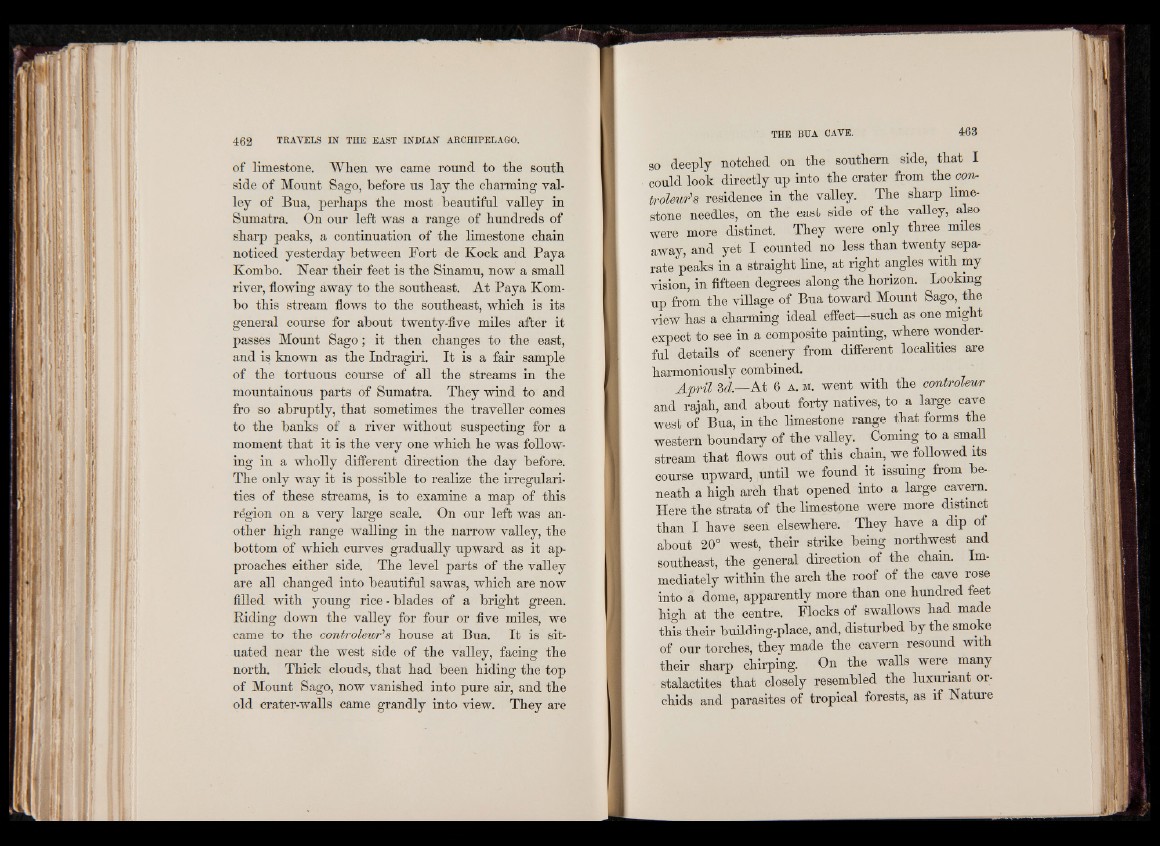
of limestone. When we came round to the south
side of Mount Sago, before us lay the charming valley
of Bua, perhaps the most beautiful valley in
Sumatra. On our left was a range of hundreds of
sharp peats, a continuation of the limestone chain
noticed yesterday between Fort de Koch and Paya
Kombo. Near their feet is the Sinamu, now a small
river, flowing away to the southeast. At Paya Kombo
this stream flows to the southeast, which is its
general course for about twenty-five miles after it
passes Mount Sago ; it then changes to the east,
and is known as the Indragiri. It is a fair sample
of the tortuous course of all the streams in the
mountainous parts of Sumatra. They wind to and
fro so abruptly, that sometimes the traveller comes
to the banks of a river without suspecting for a
moment that it is the very one which he was following
in a wholly different direction the day before.
The only way it is possible to realize the irregularities
of these streams, is to examine a map of this
région on a very large scale. On our left was another
high range walling in the narrow valley, the
bottom of which curves gradually upward as it approaches
either side. The level parts of the valley
are all changed into beautiful sawas, which are now
filled with young rice - blades of a bright green.
Riding down the valley for four or five miles, we
came to the controlev/r',8 house at Bua. It is situated
near the west side of the valley, facing the
north. Thick clouds, that had been hiding the top
of Mount Sago, now vanished into pure air, and the
old crater-walls came grandly into view. They are
so deeply notched on the southern side, that I
could look directly up into the crater from the con-
troleur's residence in the valley. The sharp limestone
needles, on the east side of the valley, also
were more distinct. They were only three miles
away, and yet I counted no less than twenty separate
peaks in a straight line, at right angles with my
vision, in fifteen degrees along the horizon. Looking
up from the village of Bua toward Mount Sago, the
view has a charming ideal effect—such as one might
expect to see in a composite painting, where wonderful
details of scenery from different localities are
harmoniously combined.
A p ril 3d.—At 6 a .m. went with the controlew
and rajah, and about forty natives, to a large cave
west of Bua, in the limestone range that forms the
western boundary of the valley. Coming to a small
stream that flows out of this chain, we followed its
course upward, until we found it issuing from beneath
a high arch that opened into a large cavern.
Here the strata of the limestone were more distinct
than I have seen elsewhere. They have a dip of
about 20° west, their strike being northwest and
southeast, the general direction of the chain. Immediately
within the arch the roof of the cave rose
into a dome, apparently more than one hundred feet
high at the centre. Flocks of swallows had made
this their building-place, and, disturbed by the smoke
of our torches, they made the cavern resound with
their sharp chirping. On the walls were many
stalactites that closely resembled the luxuriant orchids
and parasites of tropical forests, as if Nature